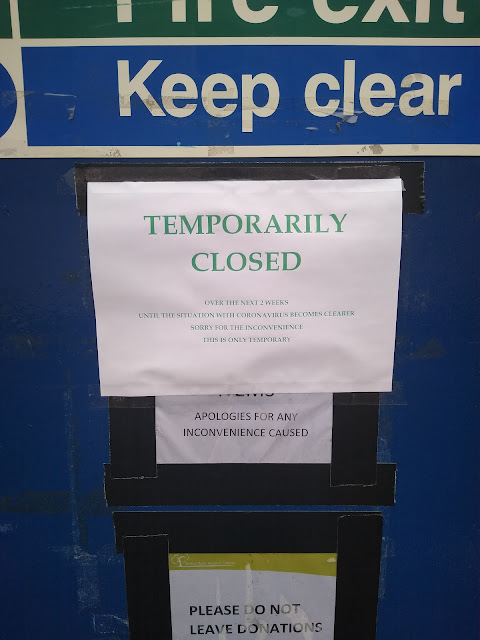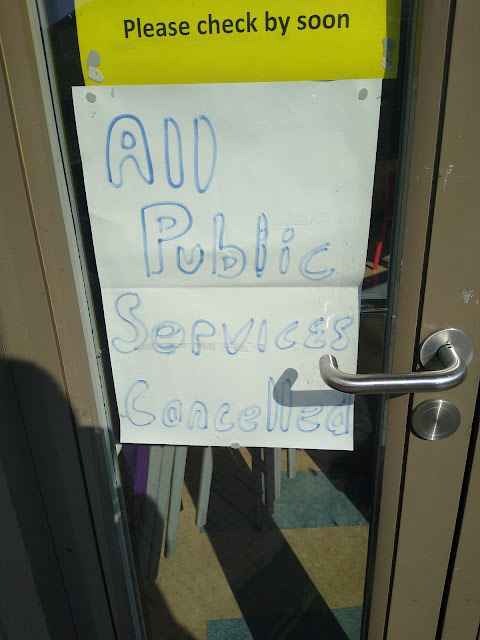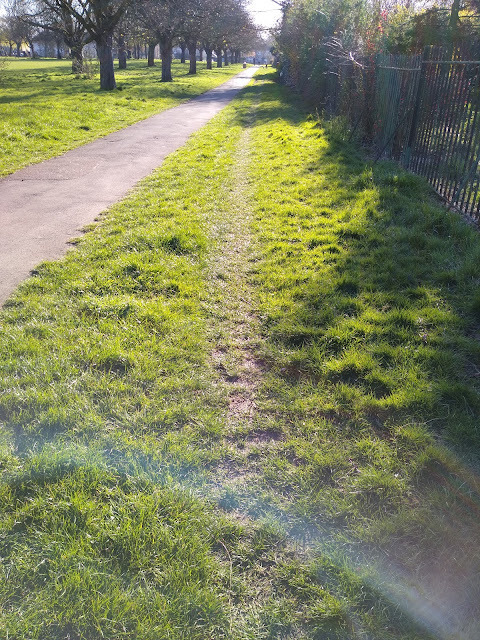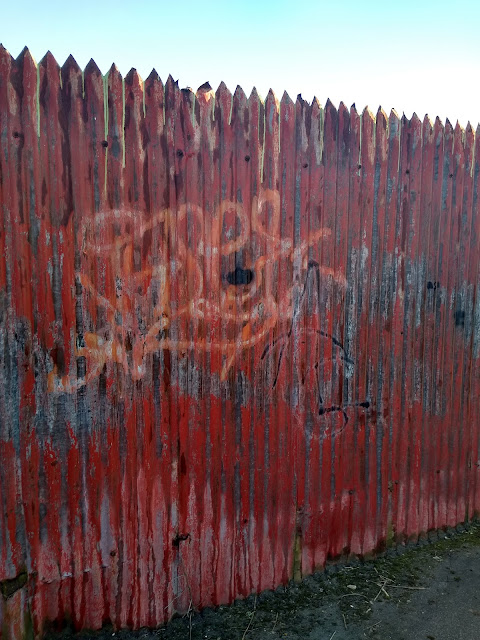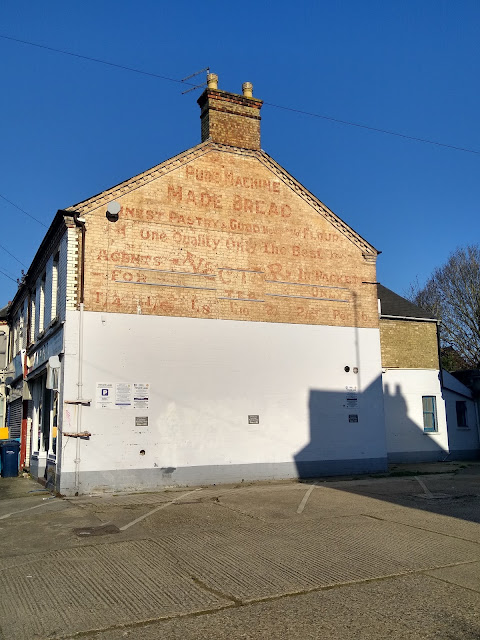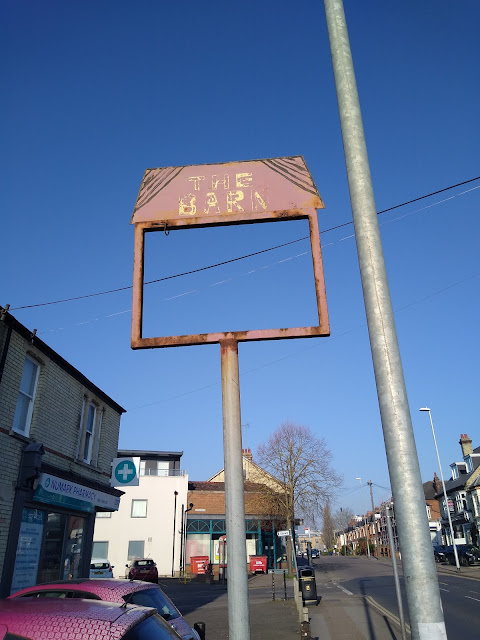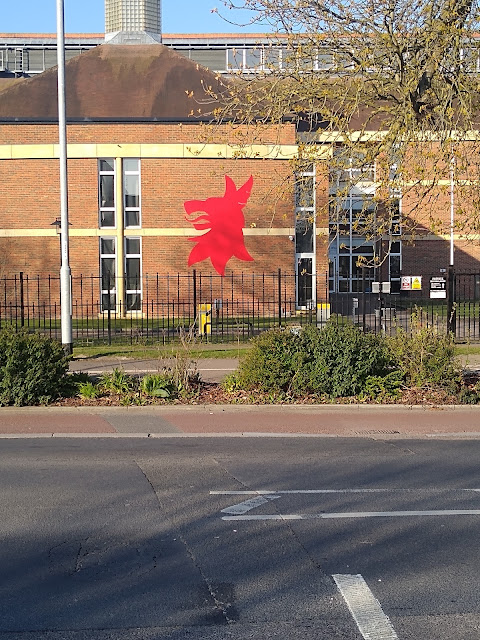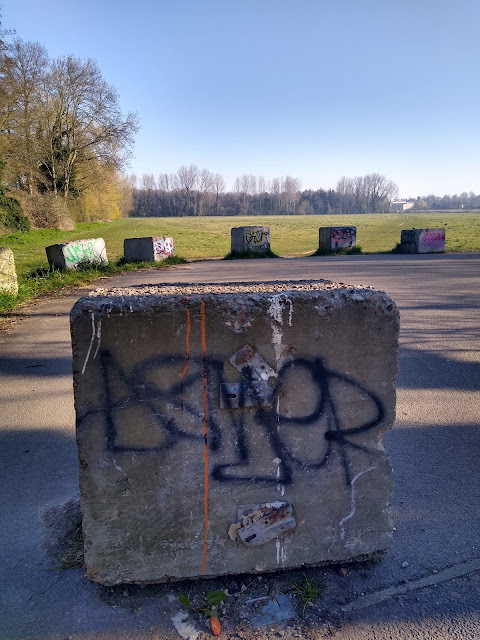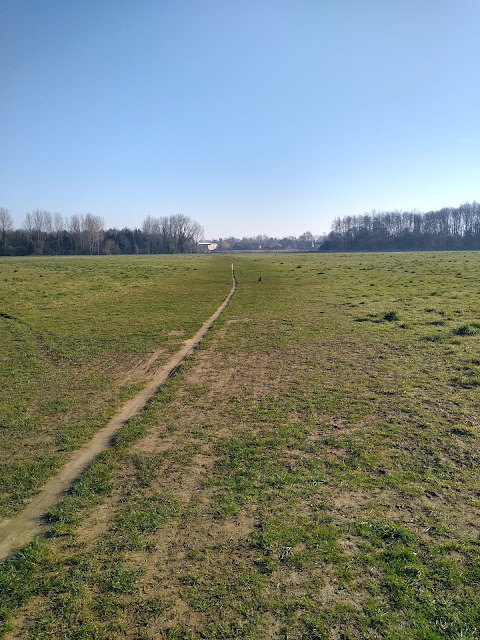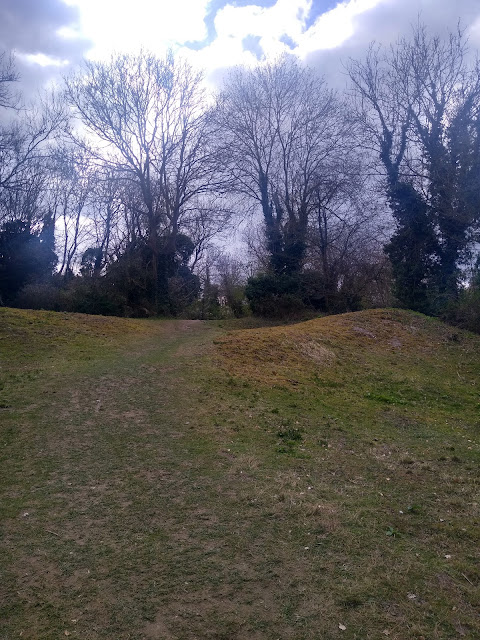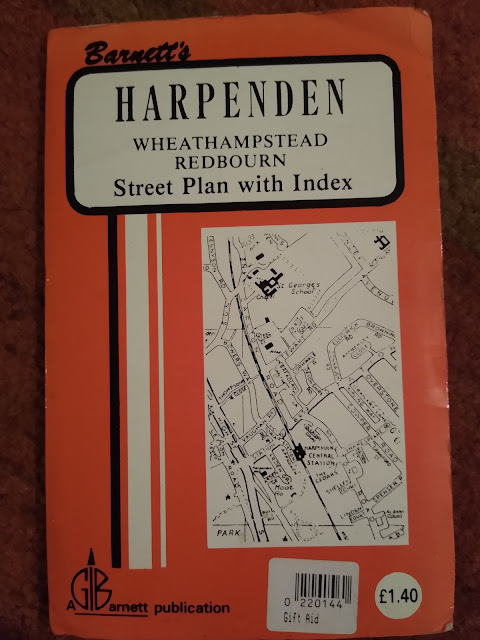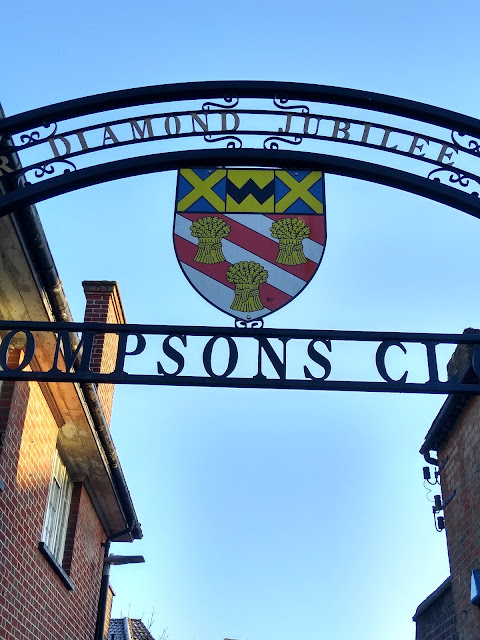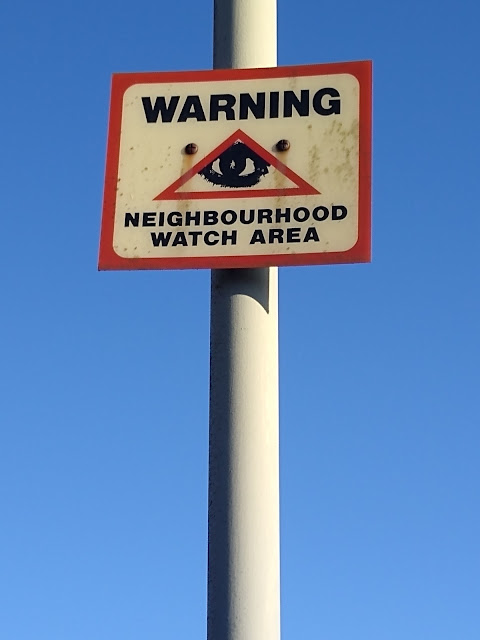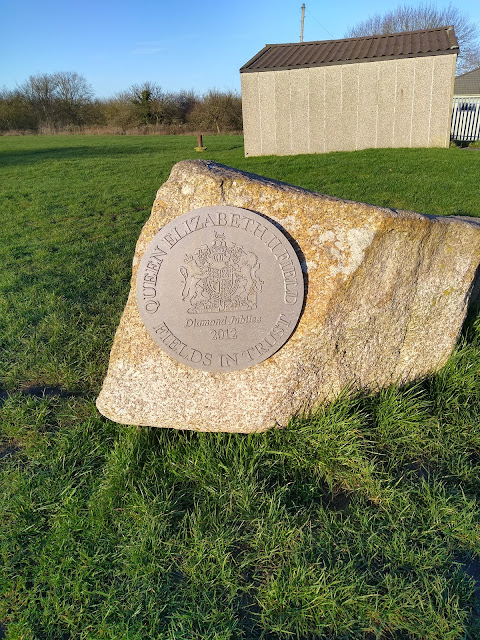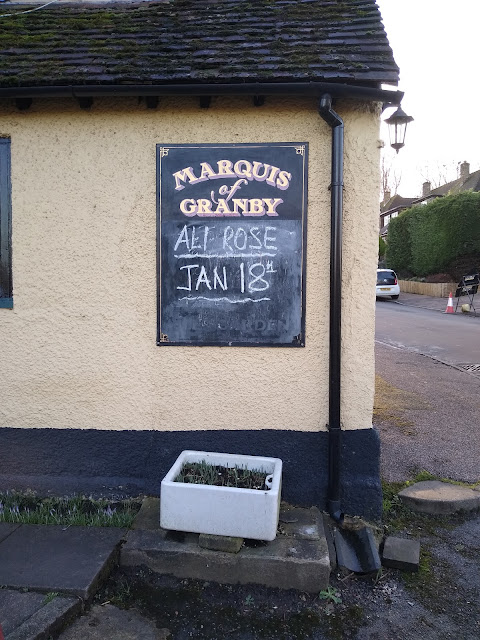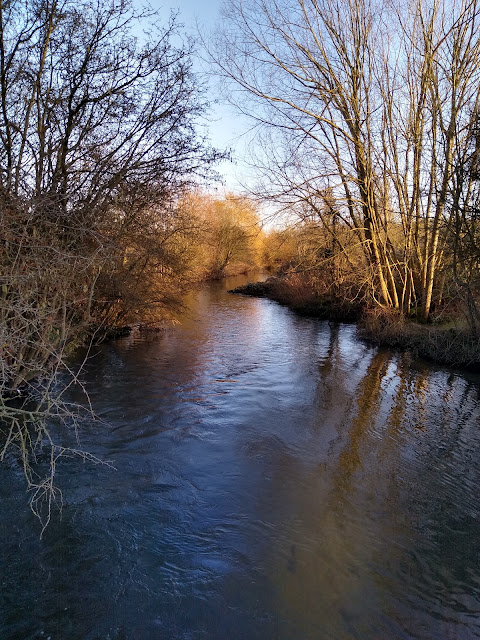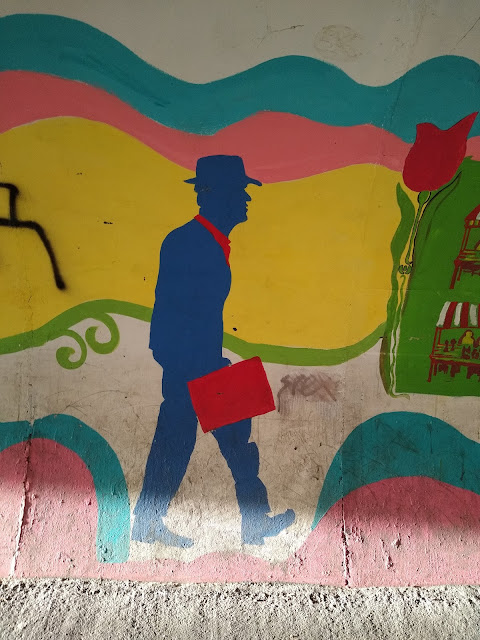Last week saw the imposition of strict restrictions on movement due to the ongoing Covid-19 situation, after the earlier and greyer guidlines contributed to a mass influx of people to beaches, National Trust properties and second homes in places like Cornwall on the previous weekend. One of the few exceptions to the current instruction to stay at home is an allowance for 'one form of exercise a day' outside the home. Walking is a named activity permitted as exercise, but how long for and how far you can wander are not specified. The guidance implies that you should 'minimise' time spend out of your home and I've heard authority figures speak of remaining 'local' but without defining firm parameters as to exactly they mean. So unlike in Ireland, where a 2km radius of the home has recently been specified, in the UK things are a bit more vague and open to interpretation, for the time being at least.
Prior to this announcement, I'd already been working at home for about a week and had already been limiting my movements as per the Government advice at the time. I began going for a walk before starting work in the morning, already practicing the 'social distancing' that had been advised and has since been more firmly instructed, now with he possibility of fines and imprisonment for non-compliance. A couple of weeks before that, just after my last blog post, I had decided it would be sensible to abandon using public transport and thus the plan for the second 'Barnett's Map' walk. The project has now had to be put on hiatus, or in the language of Corvid, 'furlough', for the foreseeable.
I've mostly confined my 'authorised exercise' to a pretty small radius from home, but struck out a bit further in the last couple of days, partly because I wanted to get a bit more distance and feel like I'd actually had a bit if exercise, and partly due to he possibility of further restrictions when 'local' is eventually defined, possibly following something similar to he Irish example. A half hour walk in the morning was sufficient to get me going in the morning and served the purpose of exploration of the previously unnoticed in the almost immediate vicinity of Coleridge and Romsey. But was insufficient to set me up for a full day indoors, physically and mentally.
Initially I found it hard to concentrate. Or more accurately to stop concentrating on a mixture of work and coronavirus related concerns. Getting out for a walk was supposed to be a distraction from all that and to provide space to escape to somewhere else, spatially and mentally, for a limited period. The exercise period was a psychogeographic ration that ought to be savoured and used wisely. After a few days I was getting better at adapting to operating within these limits. Not always taking the walk at the same time of day and occasionally replacing it with a bike ride helped. If, or more likely when, further restrictions are forthcoming, exercise options will become more limited, even confined to the home. If this happens, I will no doubt look back on the last week as a comparitively golden period to reminised over, while exercise is taken in front of the telly to Joe Wicks or Mr Motivator on YouTube. Psychogeographc activity will be confined to the static wanders; virtual imagined drifts around old maps and clunky trips through Google Street view.
On early walks, inevitably the things that stuck out the most related to Covid-19. Notices stuck in shop doors confirmed (hopefully) temporary closure or social distancing restrictions.
Observing social distancing, by keeping two metres away from others, felt awkward at first. But soon this began to shape the way I walked and became a significant director of proceedings. I began almost unconsciously to adopt avoidance strategies and now continue to employ them without thinking . When someone comes towards me I cross the road if possible, or, if a turning presents itself before I meet them, I go down it.
Of the reduced number of people around, a significant number are, unsurprisingly, joggers and dog walkers. Both present their own hazards. The jogger's perchant to posses an expectation that everyone else must make way for them has diminished slightly, but still exists, so an eye on distance need to be maintained in order to evade them before they get too near. Dogs obviously have no concept of social distancing and once off the lead are prone to running up to strangers to seek attention. I don't know if dogs can carry the virus, but since they have a surface I'm assuming they can and so treat them as something to be avoided.
These necessary precautions have made walking feel a bit like being trapped in a sort of apocalyptic arcade game, where if you accidentally stray within two metres of anyone or get coughed on you lose a life. There is also the possibility of getting stopped by the police. Even with a legitimate reason (exercise) this is something to be avoided. I've been largely keeping away from main roads to reduce the chances of an encounter.
It was good from an early stage to see that most others I passed also seemed mindful of social distancing. This made 'playing the game' a lot easier. On Coleridge Rec I found myself on an informal 'social distancing' path, already worn into the grass parallel to the official path and akin to a desire path, but formed in order to avoid joggers and offer courtesy to other walkers, rather than take a short cut. I've since notticed it's becoming more established by the day.
While the Rec is a favourite spot, it is not somewhere where people are easliy avoided, paricularly later in the day. Veering out of it, a few times I've diverted into the seemingly litle used passages that lead to Derby Road, which in turn leads onto Cherry Hinton Road. Passages such as these are small avenues of edgeland-like space, which is a rare quality in the near vicinity. Passing through them involves running he gaunlet, hoping to get through wihout encountering anyone coming the oher way, while at the same time wanting to linger and take in the world presented by objects such as the rusing corrigated iron fence below, imaginging what it's spikes protect unseen on the other side.
The reduction in cars on Cherry Hinton Road enabled me to at last get an unfettered view of the splendid ghost sign on the wall of a former bakers, without the usual car parking in front. While cars have been fewer in numbers generally, the abscence of the normal traffic jams seems to have encouraged faster by driving by those still out and about, possibly as a way to cope with the 'lockdown' and let off steam. This is a repeat of what happened during the 'Mill Road Summer' a few monthss back when the road was semi-devoid of traffic. I've added fast cars to the list of potential hazards to be avoided and diverted from, along with joggers, dogs, police cars and (more easily) other people.
Judging by the extra unofficial speed limit sign on Devonshire Road, the problem is not confined to Romsey or Coleridge, but extends over the bridge into Petersfield. I noticed the Ipswich Town sticker, further reducing he effectivelness of the official sign. Maybe an attempt by the team's fans at revenge for Town's embaressing early 1980's defeat in the Willhire Cup against Cambridge United.
Back in Coleridge, I was intrigued by the Cherry Hinton Telephone Exchange. A vintage brown single storey building that I'd noticed before but not properly. It is not sited in Cherry Hinton, being about a mile away. I imagined the operation inside was far more hi-tech that the Pertwee Dr Who Era building would suggest, with minimal human intervention required to keep operations going. A worker was starting a van down the track that runs along the side of the building as I passed, promoting me not to hang around. I wondered what was round the back.
Only a short distance along the road I paused outside a previously unnoticed electricity sub-station and allowed my shadow to project through its gateway and onto the gravel floor for a short while, inhabiting the space briefly. As I did so, I considered the immediate 'danger of death' that lurked within and by contrast the dependence we have on the eletricity provided by the infrastructure these nodes are part of. The current crisis is a stark reminder of this, in particular the reliance on the internet and modern IT to communicate. But, despite the electricity still flowing, we have yet to be presented with much in the way of decent public information films about the pandemic. There has been one, featuring Chief Medical advisor Chris Whitty reminding us of the Government's instructions, but this was not something on parr with Protect and Survive or The Aids Iceberg. It has now emerged he has contracted the virus himself, which surely presents an opportunity for a more convincing sequel.
The communal noticeboard on Fanshawe Road was even less informative. Evidently, no new notices had been inserted for years. One advertised an American Line Dancing event from several years ago. The others were too faded to read properly. I found the lack of current information perplexing and ominous. The noticeboard could be a vision of a possible future where the current predicament means that all noticeboards will eventually look like this having become redundant.
Another relic of the past, which spoke of an abandoned future, was an old sign for 'The Barn' in Cherry Hinton Road. I hadn't previously noticed it, despite walking past numerous times. I recalled a bring you own booze Pizza place being here about twenty five years ago which may have been 'The Barn' but it was too vaguely remembered to be in any way sure. The previously unnoticed sign now seemed to occupy a prominent position in the now eerily near deserted street.
Later in the week, I went beyond Coleridge, via Rock Road and into Hills Road where a large red dragon's head glowed on the side of Homerton College. Another previously unnoticed sign, this one I had no explanation for.
I continued into Long Road where I entered the field via a miniature graffitied concrete henge. Obiously meant as a barricade to prevent vehicles entering, but it looked more like a mysterious cold war checkpoint. An object of the Covid age.
The field beyond, though, brought a calming atmosphere akin to that experienced on entering an allotment site. The only other beings were crows and seagulls. The seagulls bobbed about in the grass, while most of the crows were roosting in the trees that stretched along one side of the field. A couple of the corvids wandered tentatively on the grass, as if inspecting it prior to some sort of avian field sporting event that was about to take place between crows and seagulls. I followed the desire path across the field, the only human witness to the surreal spectacle. Much better to be among the Corvids than the Covids, I thought.
From the field I joined the Busway, a starkly surreal place at the best of times, but particularly when near deserted. A couple of joggers to be avoided and a near empty train passing the other side were the only moving things I saw before arriving into Brookgate, the privately owned estate around the Rail Station. This too was largely devoid of people or other moving objects. A police car was parked up outside the front of the station. I picked up the pace to 'purposeful' and carried on past, back into Mill Road and home soon after.
The final authorised exercise walk of the week took me through the South of Coleridge and into Cherry Hinton. I passed through the post war council estate where my nana and grandad lived when I was growing up. This had the feeling of the comforting and familiar as well as containing previously unknown passages on some of its less travelled routes.
I passed through Cherry Hinton Hall, avoiding the few others I encountered. I found the old horse chestnut tree I remembered 'conkering' by throwing sticks up at as a kid. I stood under its canopy for a few minutes, dwelling in it's calm certainty. But I was soon forced to move on by the approach of another pedestrian.
I left the park due to this sudden imposition and the sight of a slightly higher concentration of people. I headed to Limekiln Close Nature Reserve, a place that used to be known as The Spinney. When I was young, it had no nature reserve status but ironically the plant life was much more prolific than it is today. The first time I remember going with my Dad, the nettles came up waist high immediately on entrance. I sat on his shoulders while he waded through. Beyond the nettles were brambles, vines, trees and overgrown bushes between which narrow desire paths had been created. There was also an array of disgarded objects to be found. Old mopeds, iron bars, random piles of dumped detritus and of course, bramble mags. There was no sign of any of these things today. As I entered the now almost manicured opening into the 'Spinney', towards the gently sloping grass mound which resembled a tumulus, the atmosphere was a bit Lord of The Rings crossed with a stranger-danger public information film. The latter due to the sudden immersion into a place where nobody was apparently around but with the slight uneasy feeling that someone or something was lurking unseen, watching.
I'd had a vague notion that it would be possible to reach the Whovian mounds and buildings of the water reservoir at the top of Limekiln Hill from the back of the Spinney. I tried to find the chalk hill that we used to sledge down, which at its submit, opened out into a farmers field. But I couldn't find it, which was odd as it used to be the most prominent feature, a focal point with an unexplained importance. Instead I clambered up through some trees roughly where I thought it should have been. At the top there was a break in the fence into the field. In one direction, part of the field was being prepared for development. In the other, just the bare field pending the emergence of crops. No official or unofficial path existed towards the reservoir. In normal circumstances I would have chanced shuffling along the edge of the field, but didn't want to draw attention to myself, aware that such an act would take me outside the boundaries of 'authorised walking'. I stood and looked across the expanse towards Fulbourn and beyond. Places far beyond where I would feasibly be able to go for the foreseeable future. I already felt like I had walked to the outer limits, pushing the envelope of 'local' only two, at most three, miles from home. The world had temporarily shrunk and become more concentrated. I wondered if there would be further instruction in the week to come to further reduce limits and enforce more defined boundaries for 'authorised walking'.
Drifting, meandering and aimless wandering..the perambulations and musings of Mr H in London, Cambridge and elsewhere.
Tuesday 31 March 2020
Wednesday 11 March 2020
The Barnett's Map Project: Episode 1 - Harpenden
Preamble
The evening prior to the inaugural Barnett's Map project excursion, I carried out the rudimentary preparations and research as prescribed in the 'rules' set out in the previous post. The journey to Harpenden would be straightforward: into London (Kings Cross or St Pancras) and back out on the line to Bedford from St Pancras. Trains were frequent enough to not to have to think about specific times.
I had been to Harpenden once before, by car, for work. I saw little of it other than a car park and an office on that occasion. Half remembered images of these two places comprised the limit of my practical knowledge of the reality of the place. Other than that, the little 'academic' knowledge I had of the town was that confined to knowing that it is in Hertfordshire and is not far from Luton, which is not.
I perused the map. The front cover was coloured orange. Inside a previous owner had drawn a diagram in pencil. This demonstrated primary colours and their various secondary colour producing combinations. As shown by the diagram, orange is a secondary colour made up of yellow and red. I wondered why somebody had marked the map with this diagrammatical demonstration. Was it part of an attempt to understand the seemingly random colours allocated to the front covers of Barnett's maps? I would probably never know.
The sole advert in the map was for Salvesens (Est. 1932), a chartered surveyors and estate agents/valuers, located at 2 Station Road. I noted the address as a possible first port of call given its likely proximity to the station.
A multitude of mysterious and intriguing names and features caught my eye as I made my way around the Harpenden map in the manner of a virtual and inefficient remote sensing drone. I selected a number of spots that I was particularly drawn to. From these I devised a sort of framework walk which, of course, could be deviated from at any time and for any reason. The looseness of the plan was intended to avoid the stress of the traditional 'itinerary' with its rushing to cram in as much as possible and disappointment if all sites on the list are not ticked off. This was not a tick box exercise and there would be no such disappointment if noted locations were not passed through. Others would almost certainly distract me along the way and desire paths would open up pulling me in different directions. That was the idea, anyway. The places selected as part of this vague strategy are italicised below:
Rothamsted Laboratory. Linked, presumably, to the nearby Rothamsted Experimental Farm, this sounded like a place with a touch of the Quatermass about it. It was located in what looked like close proximity to the town centre for a laboratory. I recalled the name 'Rothamsted Experimental Farm' from working at MAFF years ago but didn't really know anything about it.
Nicky Way Cycle and Footpath, which headed South East from a location just North of the town centre. A cycle route seemed quite progressive for a time before the number 1 was inserted after the 0 in national dialling codes. The route is shown stretching along the edge of a field belonging to the experimental farm, then crossing Knott Wood and over the B487 before disappearing off the map.
Watling Street, or at least a small segment of it, crossed the bottom left corner of the map. This is shown intersecting the River Ver and passing close to Doolittle Mill, the final feature in south-western extremity of the map. The confluence of the old Roman (possibly prehistoric) route and the river appeared as an obvious psycho-geographic node, with the Mill as an added bonus.
Beesonend Lane was the eventual outcome of a couple of footpaths across what looked like fields, heading back into the southern extremities of town. I speculated that the fields may no longer be there, and probably replaced with an estate of Barrett style commuter housing which would need to be navigated in order to get back to the main road.
Walkers Road was shown north of this, crossing Harpenden Common. Named as it was, it couldn't be ignored. This would lead across Harpenden Common and under the railway line and onward to an area containing a route of some kind called Green Lane, as well as The Grove and The Secret Spring.
North of these points, the map shows a sewage works, surprisingly close looking to a residential area. Beyond this and sited near the banks of the River Lea, both the Marquis of Granby PH and Batford Mill were both potential points for a break in proceedings for some light recuperation, near to the old boundary with Danelaw. The other side of the river was Batford, presumably an ex-village and now suburb of the town. But I fancied The Pumping Station and Hyde Mill, both upriver along the Lea, instead.
Back toward the town, The National Children's Home Farm was the outcome of a sketchy looking pathway. Beyond this, into the Northern fringes of Harpenden, The Old Bell PH might provide a second resting point of interest. After that I thought a free form walk into and around the town centre before catching a train home seemed a good way to round things off, possibly checking if the stars used to indicate 'public conveniences thus' could still be relied upon if the need arose.
Amble
On arrival at the station the next morning, I chose to exit to the left which was obviously the direction to the Town Centre. To the right was the station car park at what was the rear of the station. I hesitated before making my choice, the car park side had some attraction as peripheral zones of rail stations usually do. But the gravitational pull of the town was greater.
I soon found myself on Station Road, where almost straight away I stumbled across a charity shop. They had maps, but no Barnett's. A situation repeated in the three or four others I chanced upon later. At the other end of the street, just before its confluence with the High Street which is marked by an enormous Fuller's pub, The Harpenden Arms, was the site of the estate agents advertised in the map. It still featured a 'ghost sign' from its former life, although the name of the old business was not displayed. 'Land and Estate Agents' was boldly stated across the top of the mock Tudor facade. The whiteness behind the lettering had, with age, acquired what looked like the sort of black mould quite often found on the inside walls of damp bedrooms and bathrooms hawked by less scrupulous estate agents and buy-to-let landlords. It was as if the old estate agent had, on departure, given up the pretence and had come clean by showing the dirt. The building's function hadn't completely changed, though. Half was occupied by a letting agent called 'Space', named after the commodity that's always at a premium, even for the industry involved in selling it, apparently.
I soon found myself on Station Road, where almost straight away I stumbled across a charity shop. They had maps, but no Barnett's. A situation repeated in the three or four others I chanced upon later. At the other end of the street, just before its confluence with the High Street which is marked by an enormous Fuller's pub, The Harpenden Arms, was the site of the estate agents advertised in the map. It still featured a 'ghost sign' from its former life, although the name of the old business was not displayed. 'Land and Estate Agents' was boldly stated across the top of the mock Tudor facade. The whiteness behind the lettering had, with age, acquired what looked like the sort of black mould quite often found on the inside walls of damp bedrooms and bathrooms hawked by less scrupulous estate agents and buy-to-let landlords. It was as if the old estate agent had, on departure, given up the pretence and had come clean by showing the dirt. The building's function hadn't completely changed, though. Half was occupied by a letting agent called 'Space', named after the commodity that's always at a premium, even for the industry involved in selling it, apparently.
Onto
the high street, I was on the look out for breakfast before I properly
got going. Above a shop, an encircled wheatsheaf was embossed between
the mock-tudor beams. At first this brought to mind corn dollies and
arcane harvest rituals. Subsequent research confirmed Harpenden and
nearby Wheathamstead were once significant wheat growing areas and had
both once been major suppliers of straw plaits to the hatters of Luton.
More recently, the Rothamsted Experimental Station had been undertaking
growing trials of GM wheat, promoting protestors to descend on Harpenden
to try and destroy the crop. The hat making industry in Luton has all
but disappeared, existing only as a ghost like presence in the name given
to the town's football team, The Hatters. But had things turned out
differently, with a strong hat industry and the straw boater becoming
the contemporary headpiece of choice rather than the backwards cap,
wearing one made from GM materials produced via Rothamsted would no
doubt be considered a significant faux pas for the 'ethical consumer'
and probably result in further minor civil unrest.
An archway across a side passage off the high street featured the town's heraldic crest, depicting not just one but three wheatsheaves. This hung below ornate lettering showing that the archway was a commemoration of the Queen's Diamond Jubilee in 2012, an event I can't say I recall a great deal about. Ditto the Golden Jubilee ten years earlier. I do remember the Silver Jubilee being celebrated as a significant event in 1977, mainly due to receiving a free commemorative mug at school. I was disappointed the next year (my second year at school) to realise that free mugs were not given out on an annual basis, which for some reason I'd assumed they would be. The significance of the Jubilee had clearly washed over me and I've been indifferent to anything Royal ever since.
The same cannot be said for Councillor Michael Weaver, former Mayor of Harpenden. Seemingly because of his apparent overenthusiasm for the Monarch, he agreed to the installation of the archway in time for the Jubilee without the prior planning permission being obtained. In his defence he said he was acting in the public interest. 'It is in the public interest to show loyalty to the Queen' he explained to the local rag. The Arch was taken down after the jubilee and later put back up when planning issues were finally resolved, by which time the fiasco had resulted in significant additional cost and aggravation.
I took a diversion through the arch and down the passage (Thompson's Close) out of curiosity. I didn't get far before I chanced upon a cafe and took the opportunity for a fortifying breakfast. The breakfast was good, although the cafe was not quite of the no nonsense greasy spoon variety best suited to these occasions. But that was hardly surprising. The atmosphere I was picking up from Harpenden after reaching the High Street was best described as 'Waitrosian'. This is a common feature I've noticed of towns I've visited in the 'County of Opportunity' that orbit London on this side of the M25. By contrast, it is notably absent on the Southside in places like Borehamwood and Watford, places that are as much outlying suburbs or London as towns in their own right, only nominally in Hertfordshire.
Following breakfast, I got back onto the High Street and headed North to find the Nicky Way Cycle Path, having decided to postpone Rothamsted Laboratory. The pull in the opposite direction was greater and it would not involve doubling back, which would disrupt the flow. There was a chance I might pass the Laboratory later on my way back. I paused in a Sensory Garden, where I immediately encountered another memorial to the Diamond Jubilee, this time an iron sculpture in the form of a compass. According to this object I was heading roughly in the right direction.
Further into the garden, a display board marked the location of a number of second world war bomb shelters dotted around the town, most near the main street. One was sited near to where I was standing in the garden on Bowers Parade. The display looked towards a manhole cover marking the entrance to the shelter apparently. I didn't notice this at the time. The shelters were filled in with foam concrete in 2018 removing any possibility of future access. There had been plans to turn one shelter into a museum but it was decided this was not viable. The Harpenden History Website does not give the reason for this, or confirm when access had ceased to be possible without prior arrangement. One resident confirms that during the 1970s informal visits to the Bowers Parade shelter were frequently made by regulars of the Cock pub over the road, after closing time. Access was gained using one of several manhole covers on the green for these 'explorations', the exact purpose of which is not revealed. Maybe the chemical toilets were still operational in the 1970s.
Directly across the road the other side of the zebra crossing I took was an emporium called 'Map Stores'. So far, the journey had been fruitless as far as obtaining any additional Barnett's maps was concerned. From across the road I had visions of a shop specialising in maps, new and second-hand. But once near enough to read the writing on the window it was clear there this was not the case. The shop sold 'lifestyle' and homeware products and reinforced the Waitrosian atmosphere. I knew without entering it had nothing I was after so I moved on.
Soon after this, the High Street changed into Luton Road. I took a left and entered an area of typical Sunday afternoon suburban streets, made up of large mostly 1930s houses. I followed a street that curved round towards the North and soon saw a sign. To the left, the 'Nickey Line' headed to Redbourn and beyond to Hemel Hempstead. The sign was festooned with Lichen, unlike that pointing in the opposite direction back to town then on to St Albans, which was spotless. This seemed to indicate that taking the left hand path offered a murky, Lovecraftian route into the outskirts, while the right hand one pointed back to Waitrosian safety. I took the left-hand path.
The map had not mentioned that the Nickey Line (or Way as the map called it) was an old railway line but retrospectively I suppose this should have been obvious. It ran between Harpenden and Hemel Hempstead until the line ceased to be used around 1979 with the cycle/footpath formally established in 1985.
I left suburbia and joined the line heading towards Redbourn. Through a holloway-like initial section, it became apparent that the route was much favoured by dog walkers and joggers. The sounds of Saturday morning school sporting activities came from beyond the trees to one side of me. Further along on the other side, on emerging from the 'holloway', I passed an oblong patch of what looked like flat manure. In front of this a sign from the Animal Health Development Board requested passers by not to feed the pigs. The obvious response to this was, why not keep the Pigs somewhere else so dispensing with the need for a sign. But maybe the Pigs were the public face of Rothamsted Experimental Farm, a distraction from experimentation into GM crops and agrochemicals. However, there were no pigs to be seen. Maybe they were so experimental that they were invisible, silent, had no footprints and did not smell.
Soon after this, the route reached a junction with another footpath heading into the fields either side. At this junction, as well as a series of information boards about the history of the Nickey Line and the industrial goods it had transported (straw plaits, bricks and coal), a triad of grey-haired women with rucksacks stood in a circle, sagely considering an Ordnance Survey map. They were the first people I had seen other than joggers or dog walkers. They didn't look orderly enough or kitted out to be ramblers. I wondered if they might be maverick walkers conducting a separate but parallel excursion to my own.
To my left, the field contained sporadic areas of what I took to be wheat. It looked a bit tall to me for wheat but maybe it was an old variety. Or maybe something else. I wondered if only part of the field was planted due to the much reduced demand for straw plaits and if it catered for a handful of high end local milliners. Or maybe it belonged to Rothamsted and was some sort of experimental plotland. I decided not to venture into the field, which was not fenced off, just in case.
I carried on along the track, compelled to keep going straight despite a couple of opportunities to take footpaths to the left, which might have got me to the Watling Street/River Ver confluence quicker. I didn't stop to check; I felt no pull to divert from the straight track at this point.
I reached a point where the track met a busy road, the B487, just as it met a traffic roundabout. Here the B road intersected with the A5183, which is Watling Street apart from this interlude where it diverts from the old route to go around Redbourn. Across the road I found myself next to a small car park in a wooded area. I couldn't work out where the Nickey Line continued to begin with. I attempted to follow the bypass along the edge of the wood, thinking the continuation lie somewhere just around the corner but was shortly faced with a thicket and sudden lack of path, the way forward blocked. I then attempted to go through the wood, climbing onto a sort of ridge which I thought might be the Nickey Way, but again turned into a dead end. As I wandered through the wooded area back to the car park, I suddenly became aware of how dubious it might look to be hanging around in what had the trappings of a dogging site. I consulted the Ordnance Survey app to locate the right path, abandoning any attempt to remain analogue in order to quickly get back on the Nickey Line and away from the slightly dodgy feel of the wooded car park.
Having found the right path across the road, next to sign advertising a model railway exhibition, I relaxed and considered my sudden feeling of self-consciousness in the wood, a bit like a teenager might feel when they see a policeman even if they haven't done anything wrong. Guilt by association with the site and situation stumbled into. Before that I had felt unnoticed and unserveyed, and this feeling returned as soon as I left the scene. Once again a harmless middle aged bloke out for a walk, for all anybody new on his way to or from the shops or some other non-eventful activity, barely noticeable to the casual passer by. I do often notice such people. These ambiguous figures, like the three women I passed earlier, may or may not be undertaking below the radar psycho-geographical excursions of their own. Maybe one day I'll stop and ask one of them, but this feels a bit like breaking some sort of unwritten code of undisturbance for lone walkers.
I arrived at a sign for Redbourn, a place just outside the edge of Harpenden. I decided to break from the Nickey Line and follow the Redbourn path. It was not a place on the itinerary and also had remained unseen when I looked at the map the night before, even though it was included as a separate section and named under Wheathampstead on the cover. So much for noticing things...But now it pulled me in its direction.
The path led to a clearing where a monument consisting of three wooden posts stuck in a circle of grey gravel was the prominent feature. On closer inspection, the plaque on the middle post revealed this was the site of Redbourn's old station yard. This was also a millennium site - presumably the posts were erected to mark this occasion. The wood looked untreated and was already had crevasses and cracks. I imagined the site in years to come, lichen and moss infested with the wood blackened and rotting, the future home of woodlice. It was definitely a thing that age would add more interest to.
Shorty, I found myself in the straight High Street of Redbourn, which is the stretch of Watling Street the A Road had diverged from. It was fairly deserted considering it was a Saturday afternoon, but while the level of amenity wasn't overwhelming, the place was far from devoid of facilities. It had the feel of a 'quaint' village from an Agatha Christie TV adaptation crossed with a deserted Wild West town. I wasn't sure what was most likely to materialise first; Piorot or Cint Eastwood. In the event it was neither, and the level of desertion was maintained as I wandered in search of a shop for provisions. Before I found one, I passed a street sign for 'Saracens Mews'. Coincidentally, during the train journey earlier, I'd heard on the radio that the Saracens Rugby Club had been relegated for paying their players too much money. It turns out the area around Harpenden has significant links with rugby and the Saracens. Saracens training ground is located between St Albans and Harpenden and several Rugby playing schools in the area produce players for the professional game. Rugby, rather than football, is played on Harpenden common. I only found all this out later but at the time enjoyed the coincidence and seemingly tenuous connection when I chanced across the street name.
Just beyond was a selection of shops and other businesses. There was what claimed to be a 'traditional' pub. The sky sports sign on one of its dilapidated door confirming it was indeed traditional, in a late 20th Century way. Another pub further along was closed and boarded up. Both contributed to the Wild West aspects of the street than permeated the dominant Agatha Christie TV adaptation feel. I was half expecting the Sky Sports Door to swing open to reveal 'the Man with No Name'.
I walked the length of the High Street on along one side, stopping at a convenience store for water and a sandwich. On reaching the end, I crossed the road to walk back along the other side. A woman, who appeared more Agatha Christie that Wild West, stopped and asked me if I was lost. I said no and thanked her for her concern. Her offer of help was only superficially genuine and had the undertones of neighbourhood watch authoritarianism. Again, no longer invisible, I felt regarded ss suspicious and picked up my pace a bit, planning to walk straight back down the High Street and out of Redbourn in what I assumed was the general direction of the confluence of the River Ver and Watling Street. However, at some point to my left a long straight walled passage intervened and I couldn't help but take the diversion.
The walls eventually gave way to lower barriers to people's back gardens. A flag pole flew a limp and tattered Union Jack in the grounds of one premises. I then emerged suddenly into what at first looked like a miniature Clapham Common, a red bus passing around a large green space peppered with trees and benches.
As I moved further into the green space, the illusion of finding myself in a suburb of London dispersed. It became more reminiscent of the village green belonging to Barrington near Cambridge, which is, supposedly, the longest village green in England. I took rest on a bench and observed the scene. The only people I saw were a handful of dog walkers and joggers. The odd SUV passed through the road that bifurcated the green space, which I took to be Redbourn Common. I didn't bother consulting the map, but knew I had fallen off the edge of it at some point (the Harpenden section anyway, which was supposed to be the subject of the walk). Redbourn was featured separately on the reverse, so I considered that although I had already contravened the arbitrary 'rules' I had set out for the project, on this occasion I'd bent rather than broke them. In any case, diversions off the map of this kind were to be expected and the rules were there to be diverged from as the 'pull' if the walk demanded.
The common felt superficially isolated in time and space, with all the surface trappings of a remote rural village. But the SUV vehicles travelling along the road, the joggers, dog walkers and a general permeation of Hertfordshire Commuter Belt soon dispelled this illusion. The area was less rural than sub-rural.
I left the vicinity of the 'common', and headed in what I assumed was the direction of the Watling Street/River Ver confluence. I soon found myself along a road/track hybrid which eventually came to a wooded area where it met the Nickey Line. Just beyond was a road, possibly Watling Street, maybe the B road, I was not fully orientated and didn't consult the map, but I needed to cross it to get towards the River Ver and the confluence. Unfortunately, the way was blocked, due to some sort of roadworks. An official yellow sign imparted this information smugly, rubbing salt into the wounds by announcing the path normally would have led to the Chequers Public House. I had not previously been aware of the pub.
After somehow going around in a circle in the small wooded area, trying to find an alternative path, I resorted to the Ordnance Survey App and found a route that would mean a wide diversion across a field. Following the map, I was led partly back the way I'd come, along a ridge that was part of the Nickey Line. Just as I approached a point where the path sloped down, a loud shouty voice came from nowhere. I braced myself for an unpleasant encounter. Then about thirty of forty children appeared, along with the owner of the shouty voice, who had a large beard and was evidently in charge of them. A teacher or scout leader maybe, but one with a voice to rival Windsor Davis in 'It ain't half hot mum'. This throng soon passed and near silence descended again.
Soon after this encounter, I found myself heading down some steps to a busy B road, which had to be crossed in order to continue along the alternative route. I had some reservations about this, but didn't want to turn back. I thought back to the yellow sign and cursed it again before a gap in the traffics allowed me to run across and climb up the embankment the other side.
At the top another signpost confirmed I was on the right track, which was just as well, since the physical manifestation of the path was just about visible across the muddy farmers field that stretched out in front of me. The sun was blindingly low in the sky above the desolate muddy expanse, which had yet to sprout anything and resembled the surface of a barren planet in a bleak science fiction film. I headed across it, following Ordnance Survey and the footprints of the few who had preceded me at some recent point, in the absence of any attempt by the farmer to maintain the right of way.
After what seemed like an age, I reached a road, just wide enough for one vehicle and devoid of footpaths. I followed it towards the River, not meeting anyone until it intersected with a wider road which I took to be Watling Street. I crossed and found myself on a footpath following the River Ver.
Not far along the river path, I soon found myself at a mill. Not the 'Doolittle Mill' I'd seen on the map; this should have been back the other side of Watling Street but I never saw it. Instead I'd found the Redbournbury Mill and Bakery. Not on my map, but I had possibly slipped off the bottom briefly. Initially I mistook the seats outside as belonging to a pub garden, but there was no sign of light refreshments other than a stall outside selling bread and chocolate brownies. The mill was evidently a minor tourist attraction and several families loitered in it's vicinity.
After crossing the river, I made my way down a path behind of some large modern farm buildings, leaving behind the mini outbreak of tourism at the mill, and drifting back into an almost people free realm. I was to see no one on foot other than one dog walker for the next couple of miles, and only a handful of passing vehicles.
Just beyond the farm buildings I had to negotiate a ford, which due to the recent heavy rain covered the road like a small lake. I edged round one side and made it across just in time, before a large white van drove through. Meanwhile, I could hear the noise of shotguns coming from the nearby shooting and fishing facility, a place where countryside 'sporting' activities were contained within a fixed area. A form of sub-rural leisure and tourism.
After the ford, I found myself on another road similar to the one intended up on after the muddy field. This one had a steeper incline, but again was devoid of footpaths and necessitated walking on a narrow raised grass bank. I balanced between bushes and brambles on one side and the odd vehicle on the other, usually encountered at a bend in the road. This was a particularly disagreeable environment for the pedestrian which is probably why I didn't see anyone else on foot.
Eventually I reached a footpath turning off to the left, across a field and back towards the south side of Harpenden. I followed it, eventually emerging alongside the edge of a suburban area. A family and their dogs were suddenly walking in front of me. The path stuck to the side of the field and carried on around some trees, as if forming a barrier between the suburbs and the field. The road that ran alongside it was Beesonend Lane. The family in front stuck to the path. I diverged onto the lane, crossing the boundary from the sub-rural and into suburbia
Not far into the suburb I encountered the Hertfordshire version of the neighbourhood watch sign. I'd seen this before on a walk from Rickmansworth to London, in the depths of the interface between The County of Opportunity and The Capital. The sign, with its Scarfolkian sinister eye, was straight out of public information film dystopia. While Neighbouthood Watch signs local to me seemed to project at least a superficial nod to community, if with an undercurrent of nimbyism, the Herts version had no such pretensions. It appeared designed to impose the feeling of unavoidable surveylence, even for the locals. This might have explained the absence of any sign of human life. I felt compelled to walk 'with purpose', pretending I knew where I was going and not hanging around in the process of getting there. Even then, I had the feeling merely being a pedestrian here would be considered unusual and that journeys, no matter how short, ought to be taken by car.
I soon emerged into St Alban's Road, which ran north where it transforms into the High Street a mile or two away. Having passed through a wooded area, I followed the road until I reached Harpenden Common. I stopped here to consult the map and have a rest on a bench. I noticed several people walking around with what I first took to be pushchairs or prams, but in closer proximity it became clear these were golf trolleys. This part of the Common was given over to golf, one of several spaces on and around the edges of the map that were dedicated to the activity.
Despite golf being as popular as Rugby and taking up more land around the town, I'd managed to avoid any sign of it until now. I'd also avoided the southern part of Alban's Road which, in an earlier age,was a plagued by robbers and bandits. Most notable was The Wicked Lady, who according to legend was local noblewoman Katherine Ferrers. It is said that after a period of terrorising Hertfordshire she was shot during a robbery on Nomansland Common in Wheathamstead. These events were depicted in a 1945 film starring James Mason which was remade by Michael Winner in 1983. Although the historical accuracy of the story is dubious to say the least, several pubs in the area are named after The Wicked Lady and the legend persists. The myth has become embedded in the narrative of the landscape over the few centuries since the Wicked Lady's supposed demise, a phenomena encouraged by the leisure and tourism industry. The most significant among the many Highwaymen, robbers and brigands whose ghosts lurk just below the Herfordian surface, threatening the prevalent feeling of Waitrosian safety.
Rested, and leaving thoughts of highway robbers within the confines of the golf course, I headed towards town until I reached Walkers Road. This cut through the common, golf one side, more inclusive greenspace the other, and headed into the South East part of town from the side. I saw no walkers, but there was evidence of disgruntled school kids either using this as a route to class or somewhere to bunk off to. The road had few other features until it reached the railway bridge.
The bridge appeared like a cave, bore through rock as if created by a fearsome erosionary process, rather than being the work of men. I lurked for a bit before heading to the bright light the other end and through it emerging into an area called Southdown. This was a sort of self-contained enclave, a mini town centre. Despite a blackboard outside a restaurant boasting that it's chef had been trained by Jamie Oliver and worked for Marco Pierre White, the Waitrosian atmopsphere of the main town had not fully permeated the area. Across the road was a hardware shop and not one, but two, grease cafes. Arriving into this zone, I was greeted by a sculpture of four dancing people, escapees from the doors of public lavatories looking like they were auditioning to be the next Lyons Maid ice cream logo. I saw no reference to the Diamond Jubilee, but I suspected the sculpture had connections to the compass I'd seen in town despite it's rebellious maypole dancing connotations.
After a brief and fruitless foray into a charity shop followed a few minutes of indecision before electing not to stop in the Carpenters Arms pub for a pit stop, I headed East along Grove Road. I was tempted to turn into Dark Lane but carried on, hoping to find The Secret Spring and The Grove, the sites shown at the edge of the map I had identified before the walk. I also passed what I took to be the Green Lane, a muddy track that resembled a bridleway. I imagined it would take me out to the edge of town, but not to the Grove or Secret Spring. Again, I was tempted but having already tracked across the muddy field earlier, I decided I'd rather stay on concrete for the time being.
Grove Road at this stage resembled the 1950s council estate my Nana had lived in, in the Coleridge area of Cambridge. There were grass verges, a small rec and a small complex of semi-dilapidated garages, separate from the houses. Next to these was a small brick hut, fenced off behind barbed wire, being a facility belonging to Thames Water. This was an avatar of the ambience of the road, and marked a point where the Waitrosian influence had waned to its weakest and given up at the edge of the town.
At the junction just beyond there was what looked like a large farm house. I had a feeling the Secret Spring lay beyond this but couldn't work out how to get around it. Instead I took the route along Wellbeck Rise, which was on an incline that seemed quite steep. I was beginning to flag a bit having been walking for some time now, and the slope exacerbated this feeling. I carried on until a point where I could see a field below, with horses in. I could have kept going but it felt in the wrong direction. I was pulled back the other way.
I attempted to follow Piper's Lane back at the junction, but there was no pavement. I headed back the other way instead, considering the Grove and The Secret Spring would have to remain unseen. This was a pity but I couldn't be doing with dangerous pavement-less travel down bendy roads at this stage. I headed back down Grove Road and took a right turn at random.
I was wandered through a variation of suburban streets, which gradually changed from 1950s council estate to 1930s sub-Metroland semis, to 1970s flat fronted-white-wood-panelled terraces, among other variations. It was like passing through a microcosmic cinema of 20th century suburban housing history in less than thirty minutes.
At the junction where this suburban hotchpotch met the relatively large Wheathamstead Road, a smaller route headed North. I took this as being the way to the sewage works, the next point I had earmarked for a visit. I passed Hilltop Walk just before entering the mouth of the sewage works road. This was a fairly recent development, not shown on my map. It wore it's priorities clearly on its sleeve. No parking, no dog fouling. The road was private, a clear dis-invitation to enter it. It looked a nondescript housing development with little to pull me in on a diversion. I carried on.
I didn't get far before realising the route was another pavement free and narrow road, a tarmac holloway festooned with pointy bushes and branches each side. A large lorry pulling a tanker, heading presumably to the sewage works, squeezed past, demonstrating there was only room for vehicles to travel in one direction. I turned back, hoping to find another safer, if more convoluted, way to the sewage works.
Back at the junction, I headed into another residential area to try and find an alternative route. I approached a small field which had what looked like a light industrial estate on one side. I was sure beyond the field was the sewage works. On the approach, in the car park belonging to some flats, was a customised jaguar car from an earlier age. A jaguar was painted on the boot and the interior including head rests was tiger striped. The logo on the back of the car said 'Mr Hussle', maybe the name of the character who owned the car. An aging medallion man, or a Hertfordshire Huggy Bear perhaps. The contrast between the customised 'Mr Hussle' and it's white painted modern non-descript neighbour, a car that looked like any other, couldn't have been bigger. I'd have included a picture but I couldn't work out how to blank out the number plate and wouldn't want to fall foul of modern data protection laws.
This became less vague when approaching the expanse of rough ground at
the end of the field which separated it from the sewage works. It was
hard to tell whether this was supposed to be off limits, or if any
clearance attempt had been abandoned and the area grown back into a
post-landfill environment. It had evidence of paths being cut through
but they looked overgrown. The ground was uneven, covered on long rough
grass, brambles and stumpy shrubs, bushes and trees were festooned with
discarded rubbish. It had featured as part of the field on the map in
Town Councils document but possibly the document was overly ambitious. Maybe the level of contamination from land fill gas, hogweed and other previously unmentioned dangers was found to be worse than originally thought and attempts to reclaim it abandoned. It remains an edgelandic no-man's land between the field and the sewage works. There was no clear path through and I gave up any attempt to enter and cross this zone. The afternoon was drawing in, producing long shadows as I crossed back towards the car park, making the place feel even more off kilter than it did already. Neither Crabtree Fields nor the strange buffer zone feature on my Barnett's Map. Instead the area is blank, obscuring landfill or post-landfill desolation that would have existed at the time.
Back through the residential area, I found myself on Crabtree Lane, which headed parallel to the sewage works and towards the River Lea. As I progressed it became less residential, more forgotten edge of town with a few outpost dwellings. I was heading down the valley of the Lea and could just about make out the sewage works in front of what looked like a chalk escarpment beyond.
Having been forced off the path by a large protrusion of pampas grass, I carried on down the slope on the road. Near the end, I found the Marquis of Granby, which on first glance looked slightly dilapidated and closed. Just as I was resigned to disappointment I noticed that an event was due to take place that very night, courtesy of a chalkboard round the back. I tried the door and was pleasantly surprised to find it open. I was in the twilight stages of the walk and rest was a welcome prospect. Inside, I found the pub was separated into two, maybe three separate rooms. Another pleasant surprise in these days of inexplicable enthusiasm for the open planned. I was glad to be able to get a pint from the bar in the back room, where I was the only customer. The landlord, having served me, returned to his other customer in the other bar, where they chatted and watched Sky Sports in London exile accents. I was left in peace to listen to the TV and their chatter, which was not imposing and formed a welcome part of the hum of the pubs low sun afternoon atmosphere.
This was, I supposed, one of the many pubs named after the eponymous benefactor or at least a later replica. The Marquis of Granby AKA John Manning, was a philanthropic soldier from the 18th Century. He bought pubs for ex-servicemen to give them a living, appalled at the lack of financial support available to them after they had served their purpose. This activity ruined him financially but ensured his name is remembered across what is probably the first proto-pub chain. If only such benevolence was on offer nearly 300 years later.
This was, I supposed, one of the many pubs named after the eponymous benefactor or at least a later replica. The Marquis of Granby AKA John Manning, was a philanthropic soldier from the 18th Century. He bought pubs for ex-servicemen to give them a living, appalled at the lack of financial support available to them after they had served their purpose. This activity ruined him financially but ensured his name is remembered across what is probably the first proto-pub chain. If only such benevolence was on offer nearly 300 years later.
After the welcome respite, I emerged back into the light. Not far from the pub I reached a footbridge across the River Lea. I crossed over to the other side briefly, to the edge of Batford where there were some light industrial units. I didn't go any further, into what presumably once was the Viking territory of Danelaw. I retreated back across the bridge, firmly back on the Saxon side of the Lea. Batford was tempting, but the day was getting on. I decided to wind my way back to the station, in a convoluted way, instead.
After following the River for a bit, I reach a weir next to a playpark on the edge of a greenspace which separated the River from a road. I crossed this a bit further along, passing, but not entering, the Amble Inn, fittingly named for ambulatory activity but it was too close to the Granby to justify another stop. After a brief diversion on a bit of the Nickey Line and around a back road which featured a Kingdom Hall and something that may have been an old people's home, I eventually found myself on a main road that felt like it was heading back to town. I followed it, noticing very little at this stage. My legs were heavy and I felt like the walk was in its final furlong.
I followed the foot tunnel under the railway, where a mural had been painted by local school children. It featured the Harpenden Heraldic Crest with its three Wheatsheaves in honour of the town. Perhaps less expected was the depiction of a commuter. Not odd in itself in a town where commuting was probably a feature of most peoples lives. But this one had a facial profile that reminded me of Iain Sinclair, walking slightly hunched with a red briefcase. Behind him was a smaller figure on a scooter, which was supposedly a child but had similar facial features, under a bald head (or maybe helmet), like a miniature Sinclair. Iain Sinclair has, as far as I know, no association with Harpenden and little with Hertfordshire. That the faces of these figures struck me as Sinclairian was probably due to the slightly off kilter state I was in due to weariness after the long walk. I was at the stage where I could keep going on automatic pilot but knew that as soon as I sat down it would be the end.
I eventually emerged back on The High Street, after intersecting on a back street with the car park and office building that were my only previous memories from the town on my last fleeting visit. I had a brief wander back in the Waitrosian Realm. But I didn't have the energy for exploring much further and the immediate late Saturday afternoon retail environment was not conducive. I quite fancied a cake and a sit down but the only outlet I passed, Yummy Mummy's, was not really aimed at my demographic. Instead, shortly afterwards I found myself in the excellent Mad Squirrel Brewery Bar, marking the end of this short lived town centre addendum to the walk and apart from the stroll back to the Station afterwards, the walk itself. Soon after, I was on the train heading home.
Post-Amble
I had, on the first excursion, stayed from the 'rules' and diverted off the map for a significant portion of the walk, into the sub-rural area around Redbourn. I had deviated off the loose route I had concocted and missed a few of the sites I had identified from the map. But staying and diversion were unwritten rules, and took precedence over the less vague written ones. I considered this a good thing.
It had resulted in the walk covering a much larger area than envisaged and being a lot longer. I had recorded the walk on the 'Simply Walking' app, which told me I'd walked about 15 miles.
I had also needed to use the Ordnance Survey app to help navigate rights of way and direction in the more remote regions I found myself in. Although I'd originally conceived the Barnett's Map walks to be analogue affairs and an escape from the 'always on-ness' that increasingly dominates everyday life, I considered this minimal concession to the digital age was justified. I had been sparing in use and had referred to the Barnett's Map enroute several times, where it would have been tempting to use google. I felt like I had managed to redress the balance between digital and analogue to a healthier state by placing the Barnett's Map at the centre of things.
The next installment
Due to the trains being out of action on the last weekend in February when I intended to do the next walk in the series, I postponed the next draw and publishing this account until today. The next possible weekend will be this one, Covid 19 restrictions permitting.
Having secured bumper haul of about twenty maps in Bury St Edmunds Oxfam bookshop the other week, the Barnett's Map list has expanded. From the revised list, the random number generator has chosen the yellow covered map of Chigwell & Loughton.
.
Subscribe to:
Posts (Atom)
